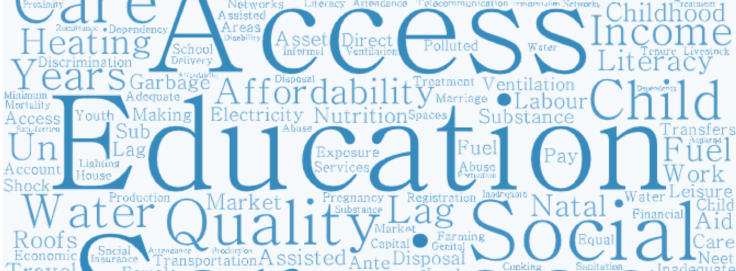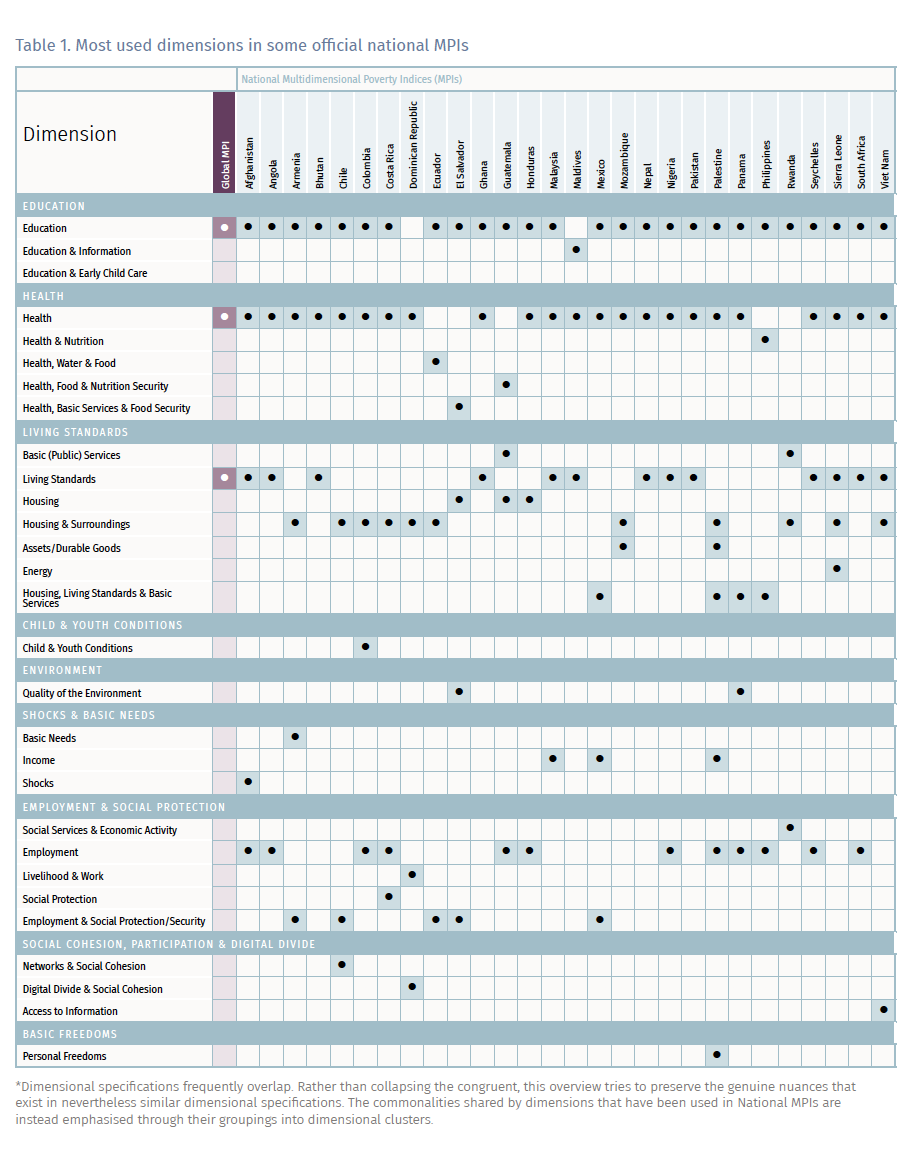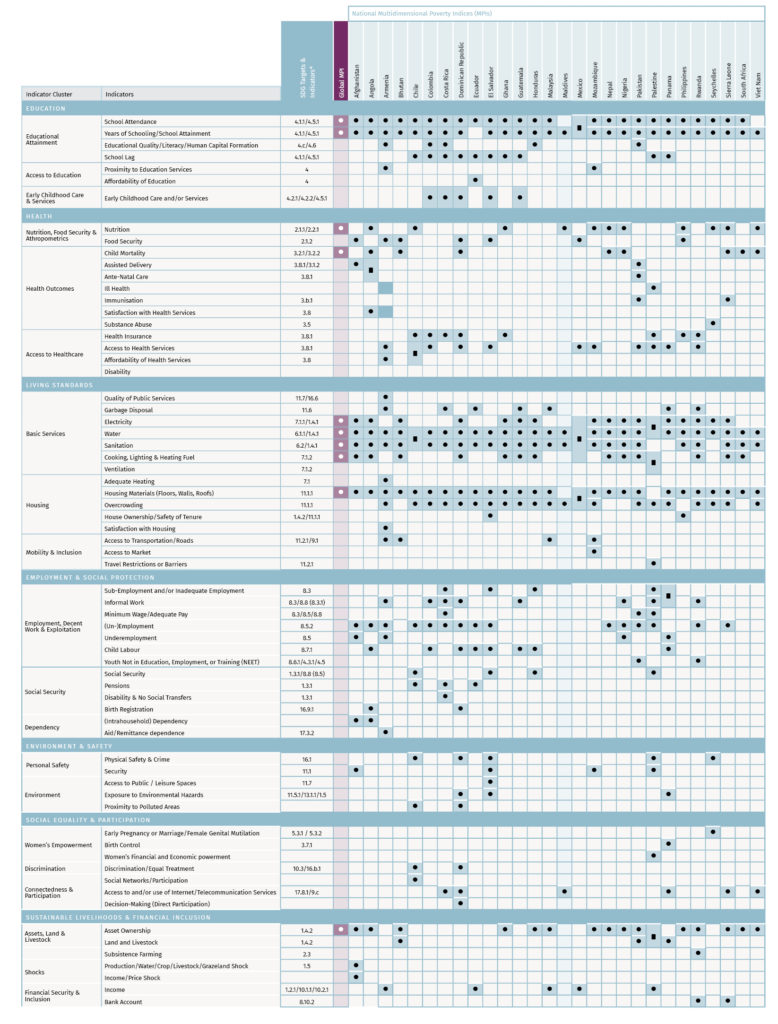
Search
Which are the dimensions and indicators most commonly used to measure multidimensional poverty around the world?

The Sustainable Development Goals (SDGs) call upon the global community to ‘End poverty in all its forms and dimensions everywhere’ (Goal 1) and specify the clear target to, ‘By 2030, reduce at least by half the proportion of men, women and children of all ages living in poverty in all its dimensions according to national definitions’ (Target 1.2). In line with – but even before the formulation of – the SDGs, a growing number of governments around the world have already started to use national Multidimensional Poverty Indices (national MPIs) to measure the overlapping deprivations people in their countries are affected by.
Poor people all over the world have referred to similar deprivations when describing the disadvantages they experience – but the different faces of poverty can also be more pronounced, or less frequently witnessed, from one society to another. For this reason, national MPIs consider key deprivations, measurement purposes, and definitions of poverty specifically by country, thus enabling more nuanced pictures of, and powerful tools for, the measurement, analysis, and alleviation of multidimensional poverty.
Each national MPI considers a unique set of indicators, grouped into the different dimensions of poverty that comprise the respective measure. What are the dimensions of poverty governments are using to measure multidimensional poverty – and which are the indicators most commonly used to capture overlapping deprivations around the world? The two tables in this article answer these questions, providing an overview of dimensions and indicators that have been used in some official national MPIs to date. Because dimensions are often similar but only partially overlapping, and because some indicators appear in different dimensions across countries, both tables also provide additional clusters and thematic groupings intended to facilitate at-a-glance overviews.
The following paragraphs summarise information on the most commonly used dimensions and indicators in some official national MPIs.
Dimensions
As Table 1 presents, there is clear consensus among all existing national MPIs and the global MPI on the importance of including the dimensions of health, education, and living standards. Indeed, there is no national MPI without dimensions that focus on these three areas, testifying to their importance in evaluations of the lives humans can lead, no matter where.
On top of these three core dimensions, most national MPIs consider at least one dimension related to employment & social protection, thus capturing important deprivations of (decent) work and public social safety nets. In addition, national MPIs have also considered dimensions such as quality of the environment, livelihood shocks, or social cohesion.
Indicators
 Education
Education
To capture educational deprivations, most national MPIs consider both school attendance and at least one indicator on educational attainment – for example the years of schooling completed by adult household members, or learning outcomes such as literacy. Other frequently used indicators include school lag and early childcare, an important indicator of cognitive development, which affects children all their lives.
 Water & sanitation
Water & sanitation
All national MPIs include deprivation of an improved source of drinking water and all but three have included deprivation of access to improved sanitation. Since these are key features of adequate housing and basic public services, they are often included in dimensions related to living standards. But because they also offer valuable information about associated health risks, e.g. due to contaminated water or lack of adequate sanitation, in some countries these indicators have been included in health dimensions.
 Health
Health
In addition to water and sanitation, two of the most frequently used health indicators are nutrition & food security. Other common health indicators are access to healthcare, e.g. as distance to the next health facility; health insurance; and child mortality.
 Housing, basic public services & infrastructure
Housing, basic public services & infrastructure
Every national MPI considers at least one, and most commonly two or three indicators on housing materials – material of floor, material of roof, and material of (exterior) walls. Other housing and infrastructure related indicators that are frequently used include electricity; overcrowding; cooking fuel; assets; land and/or livestock; and, garbage disposal. Cooking fuel is also an important health-related indicator, since indoor use of coal, dung, or leaded fuels is associated with much of the global disease burden.
 Employment & social protection
Employment & social protection
Most national MPIs consider at least one employment-related indicator, such as unemployment, informal work and/or otherwise precarious work, e.g. inadequate pay or sub-employment and/or inadequate employment. Many national MPIs also capture child labour. Together with work-related indicators, a number of national MPIs consider indicators related to social protection, such as social transfers, pensions or other forms of social security.
 Environment & personal safety
Environment & personal safety
Furthermore, several national MPIs include indicators on environmental conditions and, closely related thereto, personal safety – ranging from exposure to hazards and proximity to polluted areas through physical safety and crime in one’s neighbourhood, to personal security from different forms of violence, or combinations thereof.
Table 2. Most used indicators in some official national MPIs (click on the image)
-
Indicate sub-indicators combined into an overall indicator in that particular national MPI. Since it was logistically impossible to differentiate indicators and sub-indicators for all national MPIs in this way, some sub-indicators are listed as separate indicators for some countries.
*If SDG Targets, rather than Indicators are cited, national MPI Indicators, do not specifically – or partially – match one of the 231 SDG Indicators, but do match one of the 169 SDG Targets.
The tables show the results from 28 countries, illustrating the composition of national MPIs by dimension and indicator. Links to further information on each national MPI, including reports with results and disaggregated details, can be found on each MPPN website country’s page. Results from additional MPIs are reported in the global SDG database against SDG Indicator 1.2.2. At present, the global SDG database does not provide information on the structure of national multidimensional poverty measures.
National MPIs – purposes and processes
When considering the dimensions and indicators that have been used in national MPIs, a few procedural and contextual aspects are worth bearing in mind. Perhaps most importantly, that a measure does not include a particular dimension or indicator does not necessarily suggest that it has been considered less important, let alone unimportant, for the measurement of multidimensional poverty per se.
In order to be informative and policy-salient, national MPIs have to prioritise and integrate the indicators that capture the most important joint deprivations people in that particular country are affected by. But the definitions of multidimensional poverty, and the choice of the most important indicators will also depend quite strongly indeed both on the purpose of a particular measure and on the process by which they are chosen.
Since the specific purposes of measurement differ from country to country, indicators will be more or less attractive for each of them. For example, if a national MPI is – beyond measuring multidimensional poverty – primarily intended to serve as a policy-prescriptive tool, it will prioritise and thus often limit the inclusion of indicators to those that are highly sensitive to policy-interventions.
The structure of any national MPI will also depend on the concept of poverty against which it is being developed and on the process through which the measure is being designed.
Likewise, the absence of monetary indicators from most national MPIs should not suggest ignorance about the importance of sufficient purchasing power. But a core purpose of many national MPIs is to complement national monetary poverty measures (income, expenditure, consumption) – and this task can be made unnecessarily complicated by integrating monetary deprivation itself into a national MPI.
The structure of any national MPI will also depend on the concept of poverty against which it is being developed and on the process through which the measure is being designed. A participatory process seeking to legitimise a measure by involving various public stakeholders, representatives, and experts – including the ‘voices of the poor’ – may take a different form than a measure based on a national development plan or constitutionally enshrined guarantees.
Processes of developing a national MPI may thus start from unique conceptions of poverty that prescribe perhaps similar but nevertheless distinct sets of dimensions and indicators across countries. As the wording of SDG Target 1.2 suggests, multidimensional poverty measurements thus facilitate the agenda to end poverty in all its forms and dimensions, and according to national definitions.
And instead of including indicators focused exclusively on particular population subgroups – e.g. women or differently-abled people – national MPIs are commonly disaggregated and augmented to analyse MPI results by subgroups, thus making visible those who might be particularly disadvantaged within a subnational region or an entire country.
However, perhaps the most frequent reason for the non-inclusion of prima facie desirable dimensions and indicators is the lack of quality data. A measure may only be as good as its weakest indicator. Thus, it is often advisable to focus on those quality indicators that are currently available, with the prospect of updating a national MPI later on, when new and better data become available. That dimensions and indicators related to the natural environment, social exclusion, or participation, for example, do not frequently feature in national MPIs is not necessarily a sign of their subordinate importance. It also has to do with the difficulty of finding quality indicators that would justify their inclusion both from a technical and normative standpoint.
National MPIs usually require all their indicators to be available from the same source, i.e. a single household survey. To a large extent, it was the increasing quality, availability and frequency of household surveys that made possible multidimensional poverty measurement in the first place. Nevertheless, the importance of new and better household survey data as well as innovative techniques of merging data from external sources – e.g. geospatial data on environmental conditions – cannot be overstressed in this context.
* This article updates Diego Zavaleta’s What are the dimensions and indicators most commonly used by countries in their national MPIs? published in Dimensions 2, February 2017.
This article was published in Dimensions 11


















